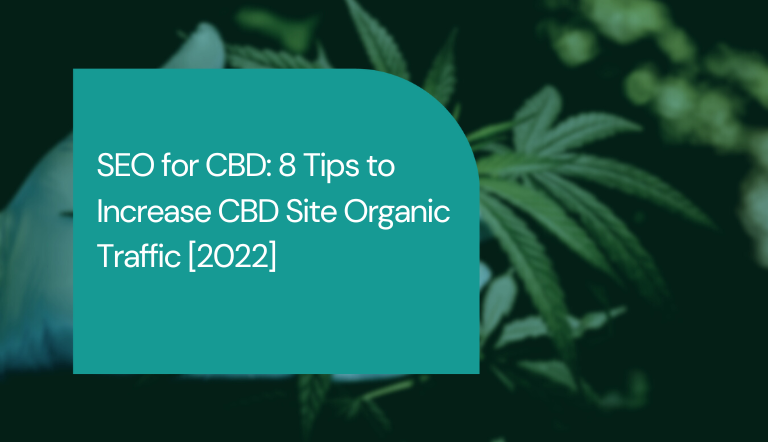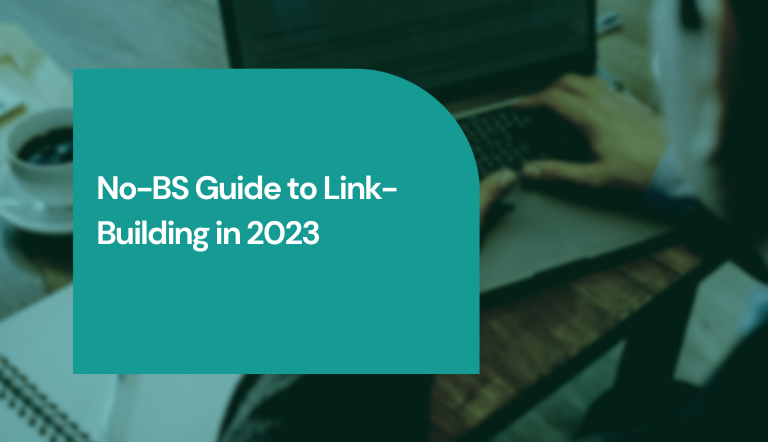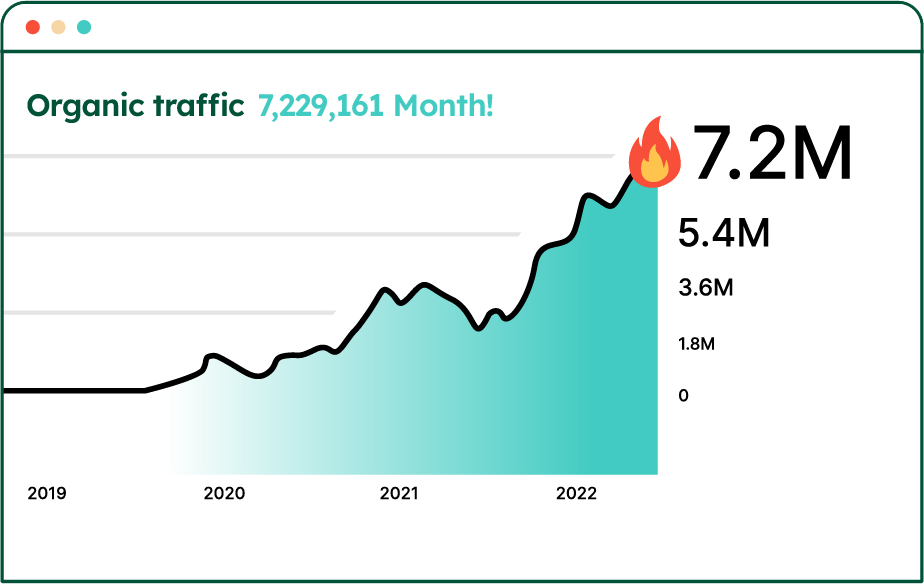Looking to grow your CBD brand?
SEO is definitely one of the best marketing channels you can pursue.
If done right, you’ll be able to drive tens of thousands of qualified (potential) customers to your website who are already aware of the benefits of CBD and looking to purchase your products.
Not to mention, with all the advertising restrictions that apply to CBD products, SEO might even seem like a breath of fresh air.
In this article, we’ll give you our best tips for growing a CBD brand using SEO! Here’s what we’re going to cover:
- Why SEO is Important for CBD Brands
- How CBD SEO is Different
- 8 Tips for Driving Organic Traffic with CBD SEO
Let’s dive right in!
Why SEO is Important for CBD Brands
Let’s start with the basics.
SEO can be a very long-term and expensive investment. You’ll need to invest in content, link-building, and SEO management, and it can take anything from 6 months to 2 years to really start driving results for your business.
So, why should you pick it over other marketing channels for your CBD brand?
Well, there are several very good reasons for this.
For one, PPC channels for CBD are extremely restrictive.
Facebook, for example, has been very strict about its rules regarding advertising CBD products over the past few years. To succeed with Facebook Ads for PPC, you’ll need to be very creative with your ads, and even if you do everything right, your ads might still get rejected.
Google Ads, on the other hand, has categorized CBD as “unapproved pharmaceuticals and supplements,” and as such, they don’t allow you to run ads on the search engine.
So, if you want to drive traffic from Google, you’ll need to rank organically. This is where SEO comes in.
Below, we’ll cover some tips on how you can make that happen.
8 CBD SEO Tips to Drive More Organic Traffic
First things first – you should know that you can’t check data on CBD Google searches via Google.

You’ll need to use a third-party tool like Ahrefs or SEMrush.
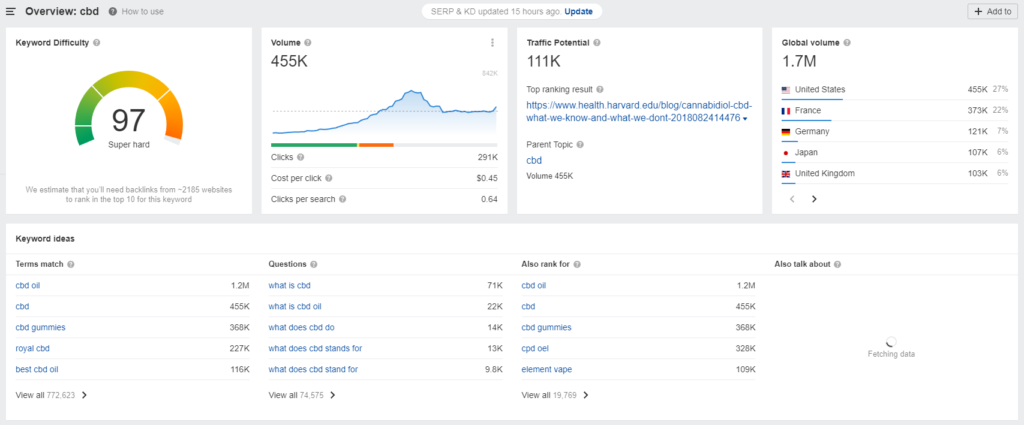
While the data from these tools won’t be 100% accurate, they’ll give you a ballpark estimate of how many people look for these keywords and how competitive the keywords are.
Now that we’ve got that covered, let’s talk about the tactics you can use to succeed with SEO for your CBD brand.
#1. Do Keyword Research Right
Keyword research is the very foundation of your CBD SEO campaign.
At this stage, you pick out the keywords that you’re going to target over the next 1-2 years.
As such, it’s important that you’re very comprehensive about this. Aim for finding anything between 100 to 400 keywords.
As for how you can do this, here’s our tried-and-tested method.
First off, run the keyword “CBD” through Ahrefs Keyword Explorer. You’ll get thousands of different keyword variations of your seed keyword.
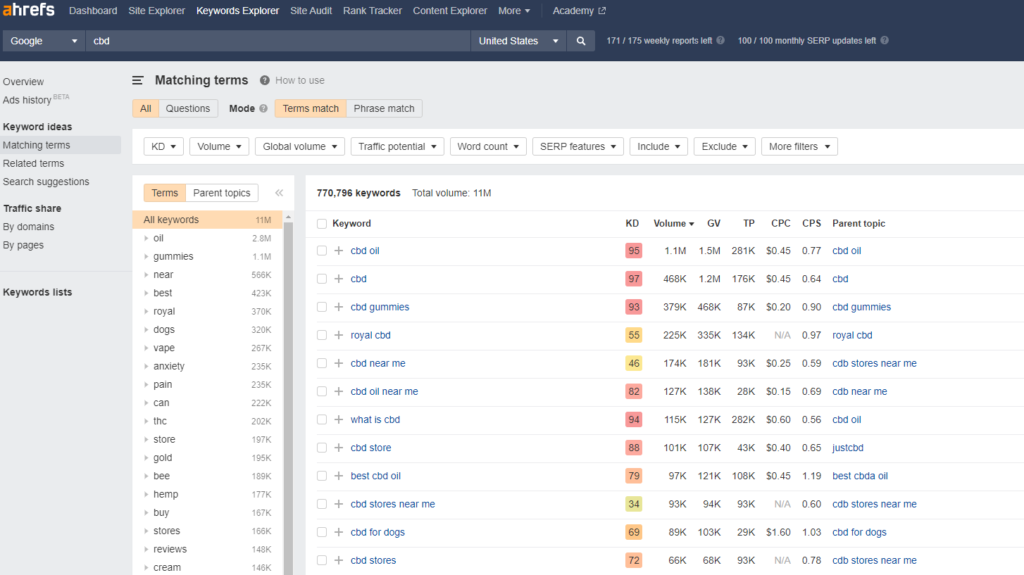
Start extracting these keywords and adding them to a Google Sheet.
Something to keep in mind here is that you should not add synonym keywords as separate keywords. For example, these 3 keywords:
- CBD store
- CBD stores
- CBD online store
Might have different search data, but they’re actually the same exact keyword. Anyone looking for one of these keywords is looking for one and the same page.
This means that you’ll also need to create a single page targeting this keyword.
Once you’re done extracting all the important keywords, you should:
#2. Split Your Keywords into Types
You’ll see that there are 2 types of organic keywords in the CBD SEO niche.
There are keywords about buying different types of CBD, such as:
- CBD oil
- CBD gummies
- CBD for dogs
And there are also keywords related to learning more about CBD, its benefits, and so on. For example:
- What is CBD oil
- CBD oil benefits
- How long does CBD stay in your system
Each of these types of keywords requires a different type of page to rank.
For the first type, you’ll need a catalog page with all your products. Here’s an example of a page done right by cbdMD:
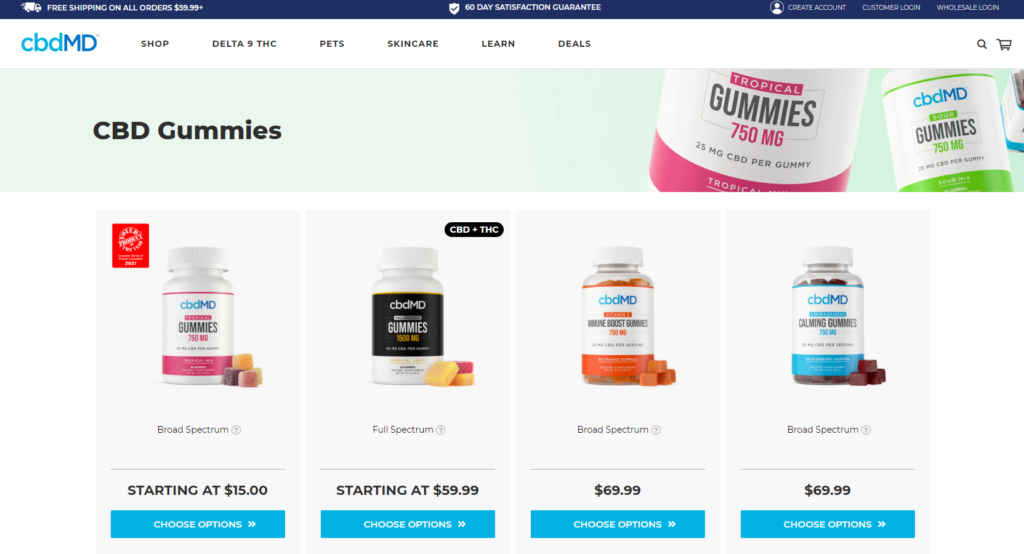
These catalog pages should be linked from your nav bar for 2 reasons:
- A link in the nav bar means that this page is very relevant to your business, and as such, Google will prioritize it.
- It’s good UX. Your customers want easy access to your different product catalogs.
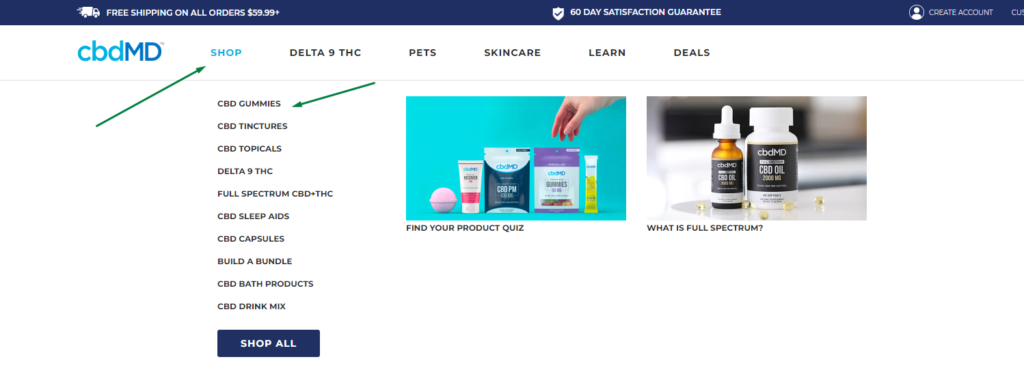
For the educational keywords, on the other hand, you’ll need to create blog posts to rank. For example:
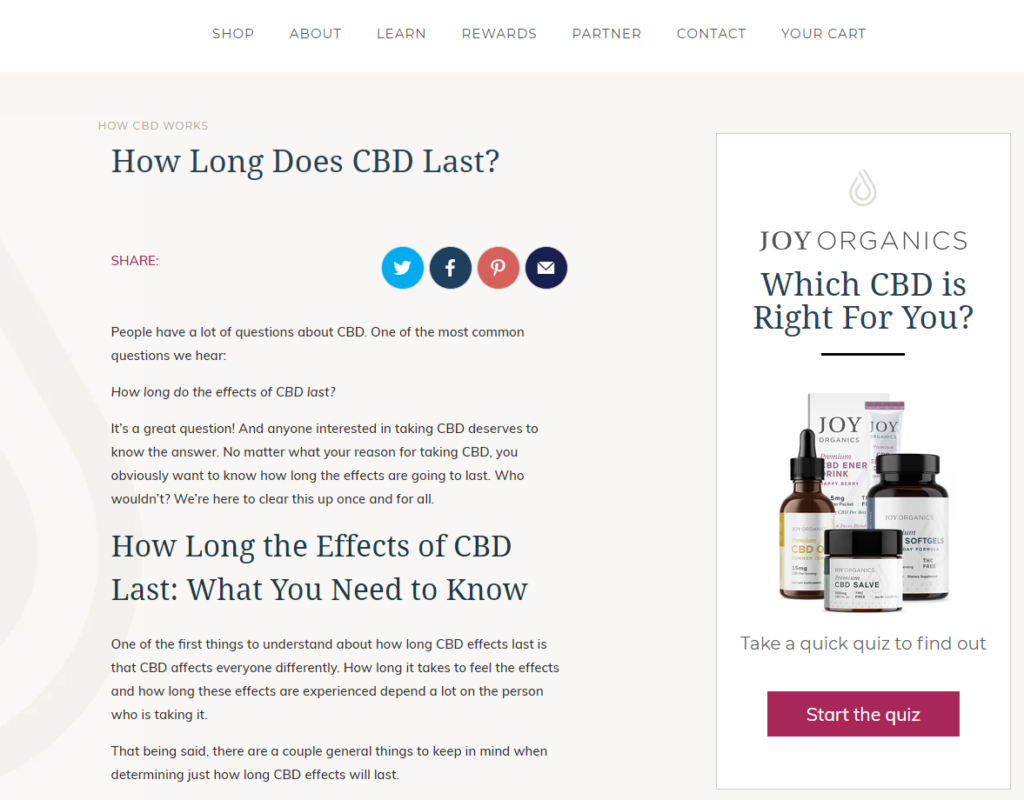
Now, you might be thinking: “why would I want to rank for educational keywords when they’re less likely to drive conversions?”
True, these pages are far less likely to drive conversions. They do, however, have their own benefits:
- They drive top-of-the-funnel traffic. While these users aren’t necessarily going to buy your products from the get-go, they can be nurtured and educated into becoming customers.
- They show Google that you’re an authority in the CBD niche. The more educational resources you have, the more likely it is for your catalog pages to rank too.
#3. Prioritize Your Keywords (The Right Way)
The CBD SEO niche is famous for being competitive. Most big CBD brands spend a ton of money on their SEO, so if you want reasonably fast results, you’ll want to be creative.
One way to beat your competition is to look for low-hanging fruit keywords.
To do this, go back to Ahrefs keyword explorer and sort your keywords by difficulty (ascending order):
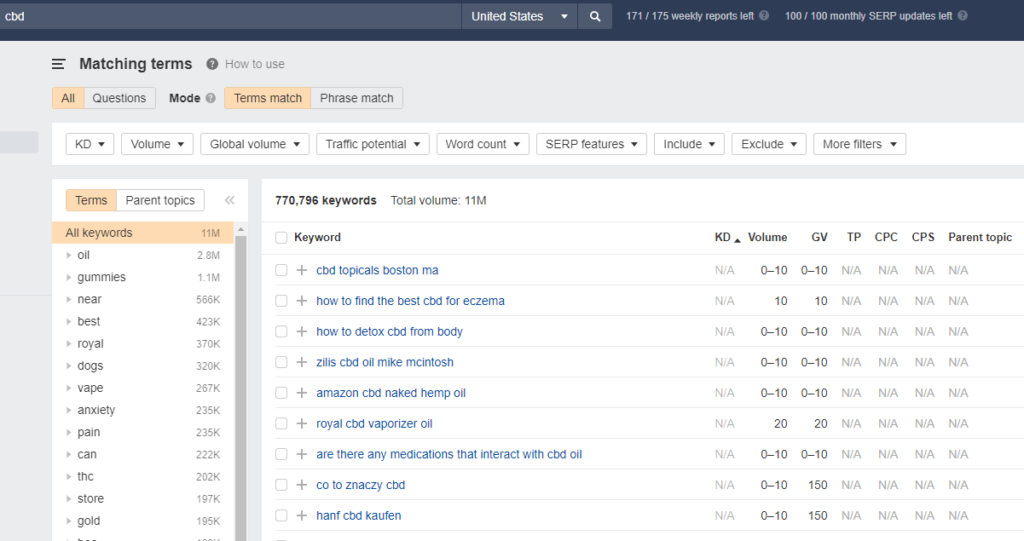
To get a more useful list, look for keywords with keyword difficulty (KD) that ranges from 1 to 100 (and exclude keywords with unavailable difficulty data).
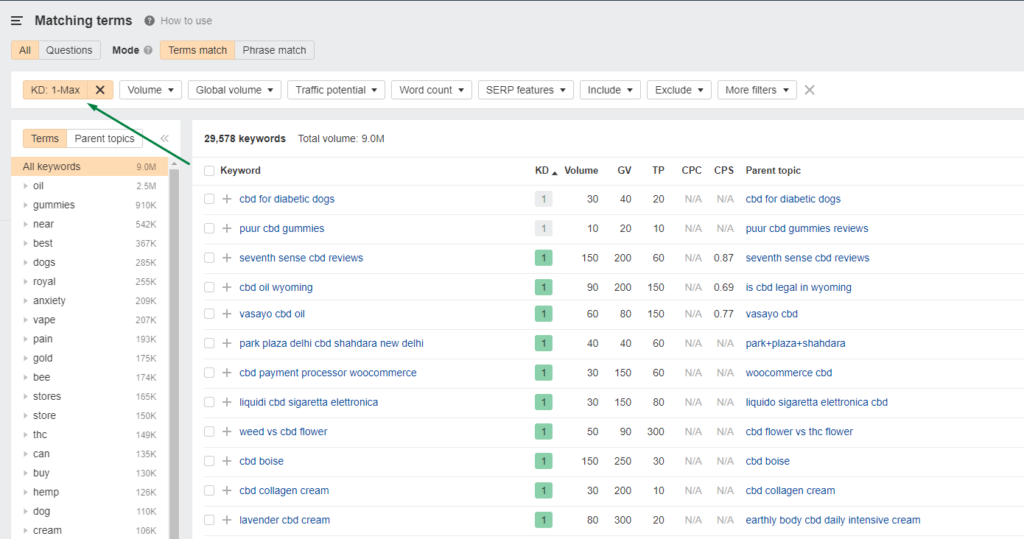
From here, start going through these keywords and extract the ones that you think are relevant for your business.
While a big chunk of the low-difficulty keywords won’t be relevant for your business, you’re bound to find the occasional low-hanging fruit – a keyword that’s likely to convert, that drives decent traffic, AND that’s easy to rank for.
Basically, anything with a keyword difficulty of less than 30 is going to be relatively simple to rank for.
Once you’ve extracted some of these low-competition keywords, we recommend you prioritize them as follows:
Priority 1 – create the catalog pages for keywords like “CBD gummies”
Priority 2 – target niche, low-hanging fruit keywords. You’re likely to rank faster for them.
Priority 3 – target more competitive keywords like “what is CBD” or “CBD benefits.” These are going to be hard to rank for, but they’re good for showing Google that you’re an authority on the topic of CBD.
#4. Expand Your Keywords List With Competitive Research
Want to take your keyword research list to another level? You can do some competitive research.
Pick out your biggest competitors in the CBD SEO niche and run their website through Ahrefs or SEMrush.
For example, if we run the Joy Organics website through Ahrefs, you’ll see that they’re ranking for a ton of high-quality, low-competition keywords, such as:
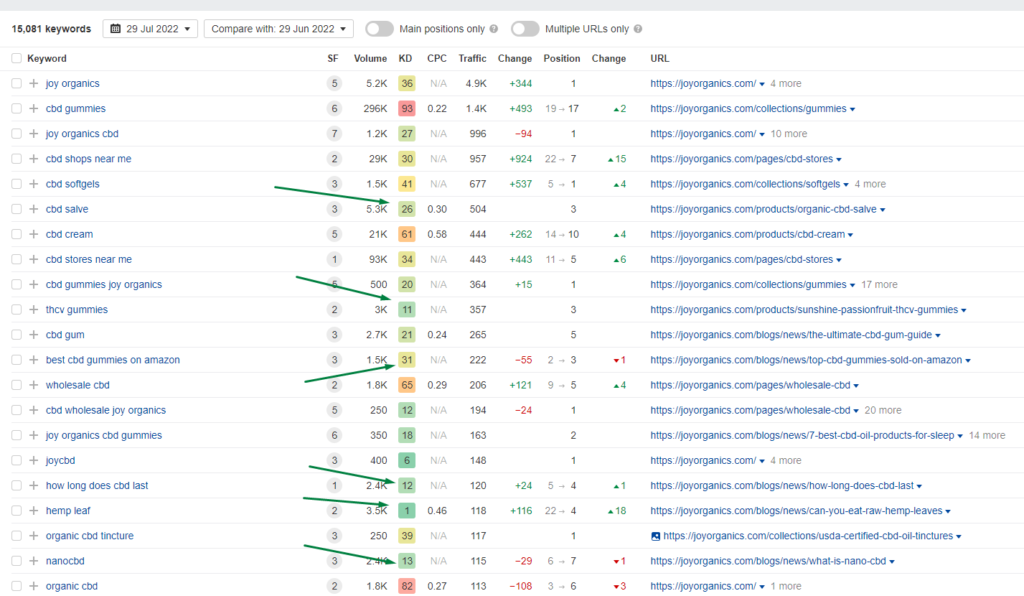
#5. Start Creating Authority Content
Once you’ve got your comprehensive list of keywords, it’s time to start creating pages targeting them.
For the catalog keywords, this is a pretty simple process:
- Create catalog pages based on the keywords.
- Optimize them for the keyword using RankMath.
- Add links to your catalog pages in your nav bar.
When it comes to informational keywords, though, things aren’t as cut and dry. In 2022, everyone and their mom does SEO or content marketing.
If you want YOUR content to stand out, you’ll need to put in the extra push here. Here are a couple of tips on how to create quality CBD SEO content:
- Make your content comprehensive. It has to be as comprehensive as the top 3 pages ranking for the keyword you’re targeting (if not more).
- Make the content engaging. Use graphics, examples, and images, as well as copywriting techniques like bucket brigades to create reader-friendly content.
- Optimize your content according to Google’s best practices (we’ll cover this next).
- Make sure your content is fool-proof in terms of grammar, style, and spelling.
- Match your content with the search intent behind the keyword. If someone is Googling “CBD benefits,” for example, they’re looking for an article that covers the benefits of CBD. They’re NOT looking for an article that, for example, simply pitches someone’s product.
#6. Optimize Your Pages for SEO
Whenever you finish working on an article, you should also optimize it according to Google’s best practices.
A simple way to do this is to install YoastSEO or RankMath and follow the instructions:
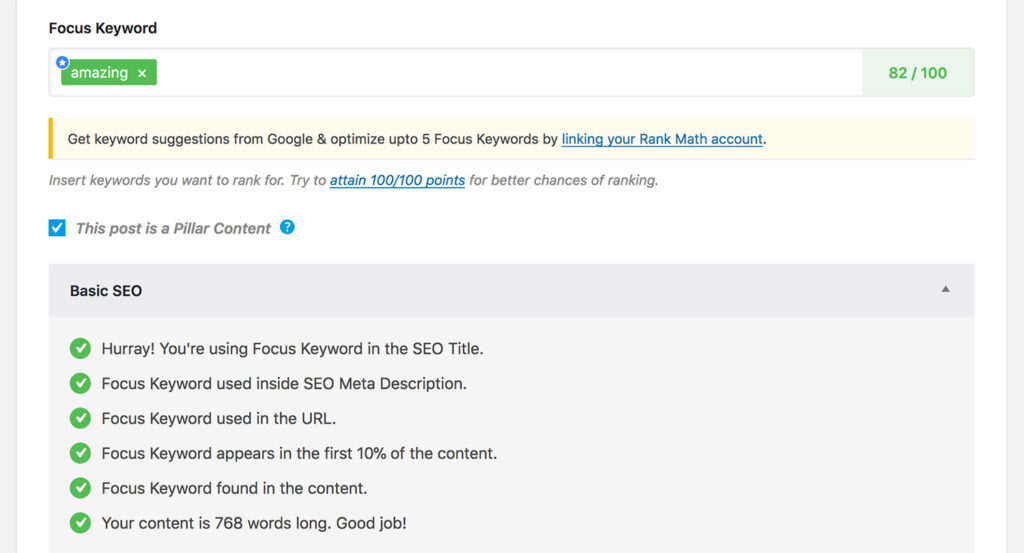
Alternatively, you can follow our checklist below:
- Maintain a keyword density of 0.5% to 2%. This means the keyword should make up 0.5% to 2% of the total word count of the post.
- Include your target keyword in the H1 and H2 headings.
- Mention your keyword somewhere in the introduction of your article.
- Include the keyword in the URL slug. Make it simple.
- Good Example: /cbd-anxiety/
- Bad Example: /cbd-anxiety-how-to-take/
- Make sure your content answers the type of questions someone Googling the keyword would have. E.g. if you’re targeting “CBD anxiety,” the questions would be “does CBD help with anxiety,” “does CBD cause anxiety,” “how to take CBD for anxiety,” and so on.
#7. Take Advantage of Interlinking
Interlinking basically means linking to some of your web pages or blog posts from other posts.
Done right, this can have a very positive impact on your website’s rankings. For example, NinjaOutreach managed to improve its organic traffic by 40% solely by overhauling its internal linking strategy.
The reason why interlinking is so powerful is two-fold:
- It helps drive link juice throughout your website. If you get a backlink to Page A, and Page A links to Page B, C, and D, parts of the link juice from that backlink flow to these 3 additional pages.
- It helps direct your users throughout your website, which increases how long they stick around (which, in turn, impacts your rankings).
As for how to do internal linking, there are some core principles that you should follow.
For starters, you should remember that the more interlinking, the better. If Page A is remotely related to Page B, you should definitely include a link.
E.g. your pages about “what is CBD,” “CBD benefits,” and “CBD anxiety” should have ample opportunities to link together.
And one last thing you need to know about internal linking is that you should get the anchor texts right. More often than not, the anchor you use to link to your pages should be associated with the keyword you want it to rank for.
To go back to the CBD for dogs example, the anchor texts could be:
- CBD is good for your dog
- How CBD impacts your pet
- CBD for dogs
- Dog CBD
- Best CBD for your dog
And any other potential variation.
#8. Kickstart Link-Building
Last but not least, there’s link-building.
Let’s start with the elephant in the room.
In the CBD SEO niche, if you want to rank, you’ll have to do link-building.
Your competitors spend 5-6-7 digits on link-building annually, so if you want to compete, you’ll need to have a dedicated link-building budget.
Here are some of our tips for doing link-building in the CBD SEO niche:
- Be prepared to pay for your links. This is pretty much normal in the niche. No one’s going to link to your website for free.
- Stick to the basics. The most effective link-building tactics in the CBD SEO niche are niche edits and guest posts.
- It’s a numbers game. You’re going to get a lot of rejections for link placements, so be prepared to send hundreds of emails per month (maybe more) if you want to build a lot of backlinks.
- Be creative with your outreach copy. The more personalized your outreach emails, the more likely it is that your link prospects will reply.
- Avoid PBNs. Private blogging networks might give you a short-term ranking boost, but if the PBN gets uncovered, your rankings are going to completely tank.
- Avoid link farms. Link farms are websites that sell links on a regular basis. Links from such websites have almost no impact on your rankings. Check out our article to learn more.
Key Takeaways
And that’s all you need to know about how to successfully do SEO for a CBD website!
Before you go, here’s a quick recap of the most important information we covered here:
- SEO is a great marketing channel for a CBD business.
- That said, SEO for CBD can also be very competitive. Just about every CBD brand out there invests in SEO.
- To succeed in the CBD SEO niche, make sure to follow the 8 tips we outlined in this article.
- Do comprehensive keyword research, create authoritative blog content, build quality links, and you’ll be on your way to ranking in no time.
FAQ
#1. What is CBD SEO?
SEO is a great marketing channel for a CBD business. It allows you to rank high up on Google for CBD-related queries and drive qualified buyers to your website.
#2. Can you run paid ads for CBD?
Whether you can run paid ads for CBD depends on the marketing channel. On Meta, you can run CBD ads as long as you follow their strictly-defined guidelines. Google Ads, on the other hand, doesn’t allow ads for CBD at all.
#3. How do I advertise CBD on the internet?
To advertise CBD on the internet, stick to organic channels like CBD SEO, social media marketing, and building an online community or email list.
#4. What’s the best tool for SEO for CBD?
The best tool for SEO for CBD is Ahrefs or SEMrush. Both tools offer a very wide range of features such as keyword explorer, backlink audits, and more.

